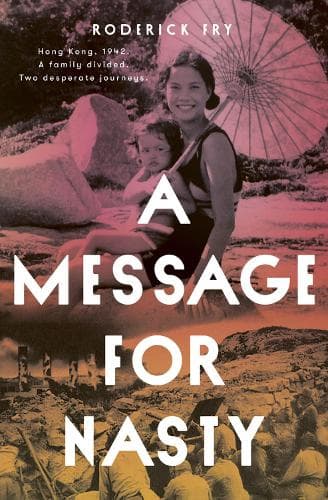Review: A Message for Nasty
Reviewed by Hannah Tunnicliffe
Lovers separated by a great war! An escape against impossible odds! Tale of remarkable courage and endurance! These are kinds of captions expected of an epic film but in Roderick Fry’s case they accurately reflect his own family history.
A Message for Nasty is Fry’s recounting of the lives of his grandparents, Vincent and Marie Broom during WWII. Vincent, a loving and practical New Zealand merchant marine engineer, met Marie, a young Macanese woman known for her directness and elegance, when Marie was already promised to another man chosen by her father. Marie was having none of that – at age 18, she and Vincent married and moved to Hong Kong.
Ten years later the stage was set for the war to break out in the Pacific and the Japanese to invade Hong Kong, with brutal results. Trouble was, at that moment in December, 1941, Marie was in Hong Kong with their four children and Vincent was in Singapore on a work project. So began a separation and journey to be reunited that would last more than two years and involve stealth, life-threatening illness, smuggled notes, disguise, phenomenal fortitude and even the advice of a fortune teller.
The circumstances in A Message for Nasty are so fraught and grim that the family’s fortunes are permanently on a knife edge. For example, should Marie keep malaria medication for her children who will likely need it in the future or sell the medication for food because her children are currently starving? Both Vincent and Marie are incredible characters and it is a great feature of the book that their stories are told side-by-side.
Marie, in particular, is a force to be reckoned with, using her Chinese appearance to her advantage, taking risks while making sure she still looks good and being told: ‘You could talk your way into anything.’ At a visit to the medical clinic Dr Selwyn-Clarke warns Marie that perseverance will be required when he remarks: ‘We have to prepare for the worst. You have to manage your affairs as if this is going to go on for years.’
The description of threats facing women in Japanese-occupied Hong Kong are particularly harrowing and Marie needs to employ all her connections, intellect and resourcefulness to survive. On a deeper level, A Message for Nasty prompts readers to consider the systems and privileges of class, race and gender and how all three intersect and impact each other during times of crisis.
While many families have a family story that could warrant a book, not many have a storyteller with the tale-telling talent, tenacity and researching chops to make it happen. The Brooms got lucky with Roderick Fry because he exhibits all three. A Message for Nasty would have been an extraordinarily difficult story to write. The historical details are complicated and evidence or memory of conversations are long gone.
Fry has done a remarkable job in ensuring historical accuracy whilst giving us a story that is gripping. As an added feature some readers will love the “History Notes” and journey maps in the back of the book while others who don’t can easily dismiss them. Personally, I would love to see a junior fiction version of this story for younger readers to learn about WWII from a different perspective.
A Message For Nasty is a natural fit for any reader who enjoys war history and nonfiction but offers enough high-stakes action for a fiction fan too. Some might say it has it all: a great love, a terrible war and the adventure that allows the former to thrive in spite of the latter.
Reviewed by Hannah Tunnicliffe
